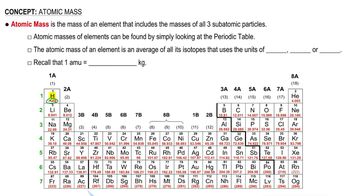Identify the element represented by each of the following symbols and give the number of protons and neutrons in each: (a) 7433X

The element oxygen has three naturally occurring isotopes, with 8, 9, and 10 neutrons in the nucleus, respectively. a. Write the full chemical symbols for these three isotopes.
 Verified step by step guidance
Verified step by step guidance
Verified video answer for a similar problem:
Key Concepts
Isotopes

Chemical Symbols

Mass Number

Identify the element represented by each of the following symbols and give the number of protons and neutrons in each: (b) 12753X (c) 8636X (d) 6730X
The nucleus of 6Li is a powerful absorber of neutrons. It exists in the naturally occurring metal to the extent of 7.5%. In the era of nuclear deterrence, large quantities of lithium were processed to remove 6Li for use in hydrogen bomb production. The lithium metal remaining after removal of 6Li was sold on the market. (b) The atomic masses of 6Li and 7Li are 6.015122 and 7.016004 u, respectively. A sample of lithium depleted in the lighter isotope was found on analysis to contain 1.442% 6Li. What is the average atomic weight of this sample of the metal?
The element lead (Pb) consists of four naturally occurring isotopes with atomic masses 203.97302, 205.97444, 206.97587, and 207.97663 amu. The relative abundances of these four isotopes are 1.4, 24.1, 22.1, and 52.4%, respectively. From these data, calculate the atomic weight of lead.
Gallium (Ga) consists of two naturally occurring isotopes with masses of 68.926 and 70.925 amu. a. How many protons and neutrons are in the nucleus of each isotope? Write the complete atomic symbol for each, showing the atomic number and mass number. b. The average atomic mass of Ga is 69.72 amu. Calculate the abundance of each isotope.
There are two different isotopes of bromine atoms. Under normal conditions, elemental bromine consists of molecules, and the mass of a molecule is the sum of the masses of the two atoms in the molecule. The mass spectrum of consists of three peaks: m/zRelative Peak Intensity157.836 0.2569 159.834 0.4999 161.832 0.2431
a. What is the origin of each peak (of what isotopes does each consist)?
